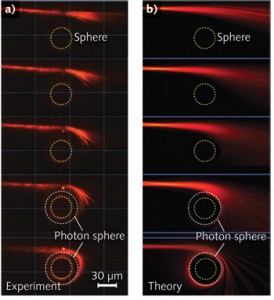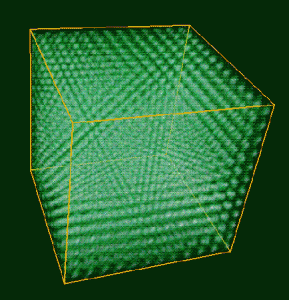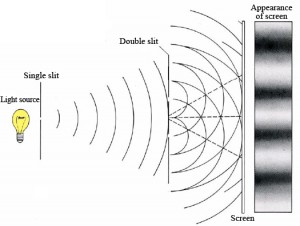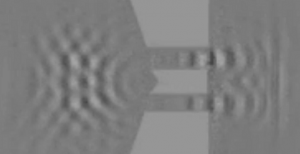Space-time versus space-density
As you probably know, special relativity (SR) and general relativity (GR) are usually described using space-time, which is an interwoven continuum of 3 spacial and one time dimension. In this model, gravity is caused by the space-time curvature.

However, what many of you probably don’t know is that there is a different but completely equivalent way to describe all this (the GR metric tensor), that does not use space-time, but space-density (Hagen Kleinerts World Crystal). This is an optical-mechanical analogy to GR, where gravity is not the result of “space-time curvature”, but the result of refraction! (If you are wearing glasses, you know what refraction is: refraction causes a change in the angle of a wave due to the change in the medium, such as air -> glasses). You are probably thinking, what?! I know, this sounds odd, so just stick with me a bit and you will see that this not as weird as you may think – with an experiment you can do in the kitchen:
You also get refraction with a density gradient, such as in a Jell-O pudding with varying Jell-O concentration, or sugar water with a sugar gradient. The image below shows a rectangular container with water and sugar. There is more sugar at the bottom than on top. When you shine a laser pointer through it, the laser beam will bend because of the sugar gradient, which causes refraction. You can actually try this yourself :-).
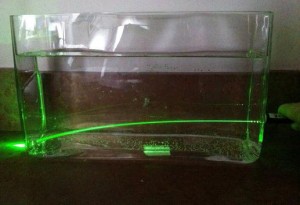
You are probably wondering, how this applies in any way to general relativity? In this model, instead of using space-time, we are working with space-density. What this means is that the space/vacuum in that model is not “empty”, but is in fact like a huge… crystal – or more generally: an elastic solid.
Ok, I can already hear the “but…?”: the most important point first: this space/elastic solid, is not made of ordinary matter. Think of it more like “the fabric of space” or similar – an immaterial structure of some sort. And the question of “how in the world would we move through this solid” is not even the right question as you will see… but one thing at time (I will try to address all of these “but…?” questions :-).
This elastic solid (just think of it as “space”) is compressed in certain places – in places where there is more matter. Just like Einstein said: matter bends space, and this bent space “tells” matter how to move. Except we are not considering space-time, but space-density as our metric. For instance, space would be denser where the sun or a planet is compared to somewhere in outer space.
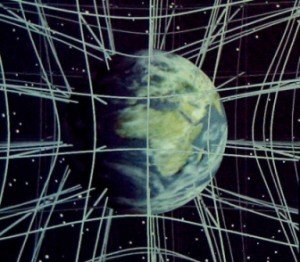
Changes in density, as you can see with the Jell-O (or sugar gradient) causes changes in the refractive index, which means, light will always bend towards the areas of higher density. Hence, if space is denser where the sun is, light would (slightly) bend towards the sun. (This is similar to what people sometimes refer to as “the bending of space-time”, except, that we are now using an elastic solid – like a Jell-O). This is not my crazy idea, I swear, there are many papers on this (see below), and as we explore this idea further, I hope you can see that it is not as silly as it may seem now!
Note: if you are thinking of the word “aether” or “ether”, forget it again, quickly, because there are just too many (wrong) interpretations of this word. This not like the “ether” that people were talking about (except Einstein, see his remarks in the speeches section!). First of all, that “ether” was sometimes considered to be a gas or a fluid. It has been shown in several experiments that this cannot be correct. Also, at that time, people did not know about quantum mechanics yet, and thought that matter would have to move “through” this “ether”. As you will see later, this is a misleading question. The famous Michelsen-Morley experiment however did not disproof the model of “space as an elastic solid” model. The elastic solid model is completely equivalent to the “Minkowski space-time” model (see links below).
Optical Black Holes
What if space gets so dense that the refractive index is so large that light can no longer escape? Then you get a black hole. The optical analogy does not just stop there – it is actually possible to create a real optical black hole, by using a material with a smoothly increasing refracting index. In this case, the refraction is such that the the light will always bend towards the center no matter from which direction the light originates:
Of course this is nothing scary, and it is very real – people do this in the lab. It is simply a play with refraction. People are actually using this model now in the laboratory to study actual black holes (since the real ones are kind of difficult to create in the lab :- ). Some people are even considering to build super solar cells that contain such optical black holes.
You may wonder, well this is all fine for light, since we know refraction works. The suggestion above was that this is actually equivalent to general relativity, so, this would also have to include matter, and surely, matter is totally different from light and there is no way there could be any kind of optical analogy, right? But before we dive into this, we will do an excursion into solid state physics.
Crystals and Elastic Solids
In solid state physics, people are often dealing with crystals and elastic solids. Now as it happens, crystal with defects and elastic solids with deformations can be described with the same non-Euclidean geometry as space with curvature and torsion (and the same way as the optical-mechanical analogy shown above). So a solid space with compression (and torsion) can be described the same way as actual, real crystals or elastic solids!
With the recent advances in solid state physics, there are more and more papers about this topic (see below), people are now using general relativity and apply it to crystals, and the other way around, they use crystals to learn more about general relativity. So this is no joke!
What do you think happens when you hit such a crystal (without breaking it :-)? We end up (among other things) with phonons, which are quantized vibrations, also called “particles of sound” or even “particles of heat”! Yep, no kidding!
Phonons: “Particles” of Sound
Why in the world would we use the word particle here? Clearly, a vibrating crystal (or a jiggling Jell-O) can be described with just vibrations (waves), and definitively not with “particles”. Interestingly though, these vibrations actually exhibit a particle-wave duality, because their energy levels are quantized, just like photons! They are actually described using quantum mechanics, and even more, they are considered to be bosons, just like photons are.

Like photons, the energy of a phonon is E= ![]() . So if they are described like photons and act like photons, would it be possible to create a phonon laser? A laser of sound, in a way? The answer is… yes :-). In several recent articles researchers were able demonstrate “coherent phonons”, which is the first step in constructing a “phonon laser” (more links at the bottom)
. So if they are described like photons and act like photons, would it be possible to create a phonon laser? A laser of sound, in a way? The answer is… yes :-). In several recent articles researchers were able demonstrate “coherent phonons”, which is the first step in constructing a “phonon laser” (more links at the bottom)
And would it actually be possible to do a double slit experiment with phonons, like we can do with photons?
The image above shows a typical double slit experiment. When light passes through two slits that are close to each other, then you see an interference pattern on the screen. This is one of the typical experiments to show the wave nature of light.
We can do just such a double slit experiment with phonons (in this case: polaritons). Below is an image from a video from MIT about just such an experiment. I think that’s quite amazing! Why? Because of all the mystery surrounding that “magical and weird” double slit experiment, where nobody seems to be able to give a clear answer of what exactly happens (is it “consciousness” collapsing the wave function? Is it parallel universes?)
Yet here we are, with the same kind of experiment, with quasi-particles that exhibit the same wave-particle duality as photons, yet, where is the magic? Where is the weirdness? These phonons are clearly waves, and exhibit the same behavior as photons and produce the typical interference pattern in a double slit experiment. Here it is clear that all that happens is that actual waves/vibrations are moving in a crystal, and interfere with each other. The waves are spatially spread out, and so can influence parts of the wave on the other side of the slit. We don’t need consciousness to do anything here, we don’t need parallel universes either.
Let’s get back to the “Crystal Universe” idea by Hagen Kleinert: in this model, the universe (you can use the word space or vacuum), is basically just like such a crystal (or at least, an elastic solid – like a firm Jell-O – but not made of ordinary matter!). In this model (whether real or not), photons would in fact be exactly like phonons. They would indeed be true waves, vibrations in that “solid space”. This “crystal” may be discrete or not. If it is, then the lattice size must be around the Planck length (since this is the smallest known length). But, as an approximation, as long as the frequency of the phonon or photon is large compared to the lattice size, the calculation is the same as for a continuous medium (see chapter 6.5 in “Materials Science”). (Personally, my guess would be that it is discrete – in a later post I will add more speculative thoughts on this and possible experiments on how to distinguish the two models)
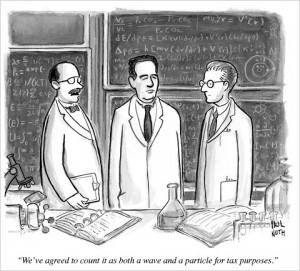 Most (mainstream) physicists (except for instance Schrödinger!) will tell you that in he case of photons, we are dealing with a “probability density function” and not real waves. They will tell you that the result of the double slit experiment can only be explained by one of several (“weird”) explanations, including: parallel worlds, the Copenhagen interpretations (that somehow looking at something decides the outcome), the many minds interpretation and several other models. All except basically that photons are simply… (quantized) waves :-).
Most (mainstream) physicists (except for instance Schrödinger!) will tell you that in he case of photons, we are dealing with a “probability density function” and not real waves. They will tell you that the result of the double slit experiment can only be explained by one of several (“weird”) explanations, including: parallel worlds, the Copenhagen interpretations (that somehow looking at something decides the outcome), the many minds interpretation and several other models. All except basically that photons are simply… (quantized) waves :-).
Yet at the same time, in the case of phonons in a crystal (and any other quasi particles!), which are described just like photons, there is nothing magical or weird at all, and none of the same physicists above would claim otherwise. We definitively don’t need parallel universes to explain the interference pattern of phonons. And we don’t need any “conscious observer” to cause a “wave function collapse” in a phonon – there is a paper on this:
“The quantum mechanical properties of phonons in a one-dimensional lattice are studied, with the conclusion that the phonon behaves in all essential respects as a normal quantum particle. “Wavefunction collapse” of the phonon state is shown to occur in an automatic way when an observation is made. This gives possible insight concerning the nature of wavefunction collapse in the general particle case”
It is simply a matter (no pun intended) of waves that are interacting with each other, cancelling each other out at some places, and when being “measured”, transforming into another wave (or interacting with another wave). Doesn’t that make you wonder if we really do need all that weirdness in the case of photons? Of course, you might consider the idea of “solid universe” weird (I first did). But maybe if all the other “weirdness” vanishes, maybe it is not so weird at all.
You are probably thinking, well photons is one thing, but matter has got to be completely different though, after all we are dealing with actual “particles” there such as protons and electrons, right? Clearly, the analogy ends here, or does it? I mean, how would particles move through a solid space? (That’s actually a misleading question, as you will see in a later post)
Puzzle Piece 2: What’s the Matter with Matter?
Summary
At the end of each post, I will update this table that shows the differences between the two models that we have seen so far – the mainstream “space-time” versus the “space-density” model:
Space-density Universe
|
Space-Time Universe
|
|
| Tags | elastic solid, crystal universe, optical-mechanical analogue, space exists | Minkowski, space-time, absolute space does not exist |
| GR Metric Tensor | space-density (space with compression) | space-time |
| Cause of Gravity | refraction (density gradient, optical) | curvature of space-time |
| Photon | quantized wave, similar to phonon quasiparticles in crystal (vibrational mode), there are no photon “particles” | probability density wave function, no “real” wave, probability of finding photon |
| Double Slit Experiment | real waves interfering (like phonons) | parallel universes, no real wave, “consciousness” ,probabilistic… |
Links
Optical analogues of General Relativity:
- Hagen Kleinerts World Crystal:
https://www.sbfisica.org.br/bjp/files/v35_359.pdfh - Defects and Diffusion in the Planck-Kleinert Crystal:
http://www.znaturforsch.com/aa/v62a/s62a0564.pdf - De Felice, F. On the gravitational field acting as an optical medium. Gen. Relativ. Gravit. 2,347–357 (1971).
- On the optical-mechanical analogy in general relativity: http://arxiv.org/abs/0905.4479
- The Classical Wave Theory of Matter by Robert Close: http://www.verumversa.com/
- Analogue Special and General Relativity: http://arxiv.org/abs/1302.6729,
- Mimicking general relativity with Newtonian Dynamics:
http://www.hindawi.com/journals/isrn.mathematical.physics/2012/260951/ - A Table-Top Test for General Relativity? http://www.universetoday.com/35384/a-table-top-test-of-general-relativity/
- A condensed Matter Interpretation of SM Fermions and Gauge Fields (Ilja Schmelzer):
http://link.springer.com/article/10.1007%2Fs10701-008-9262-9,
http://arxiv.org/abs/arXiv:0908.0591 - The Cell lattice model (Ilja Schmelzer): http://ilja-schmelzer.de/clm/
- Analogue Gravity: https://arxiv.org/abs/gr-qc/0505065
- General Relativity in Electrical Engineering:
http://www.int.kit.edu/downloads/RG_Pernice/Paper21.pdf - Lorentz Contraction of Space and the Gravitational Field:
http://vixra.org/pdf/1008.0023v2.pdf - Surprising Connections Between General Relativity and Condensed Matter: http://arxiv.org/abs/1010.2784
Optical Black Holes:
- First black hole for light created on Earth:
http://www.newscientist.com/article/dn17980-first-black-hole-for-light-created-on-earth.html#.UwiBW_l5M1I - Physicists Make Artificial Black Hole Using Optical Fiber:
http://spectrum.ieee.org/aerospace/astrophysics/physicists-make-artificial-black-hole-using-optical-fiber - Analytical Theory of Optical Black Hole Analogues:
http://arxiv.org/abs/1209.5148 - Trapping light by mimicking gravitational lensing:
http://www.nature.com/nphoton/journal/v7/n11/full/nphoton.2013.247.html - Creating Optical Black Holes to Produced Super Solar Cells: http://www.dailygalaxy.com/my_weblog/2009/10/-creating-micro-black-holes-to-produce-super-solar-cells.html
- ‘Black hole’ made from light: http://www.nature.com/news/2008/080306/full/news.2008.651.html
Phonons: Particles of Sound
- Definitions of Phonons:
http://physics.about.com/od/physicsmtop/g/phonon.htm,
http://en.wikipedia.org/wiki/Phonon - Double slit experiments with phonons: http://nelson.mit.edu/node/178
- Fantastic Phonons: http://www.sciencedaily.com/releases/2013/11/131113143215.htm
- Black body analogue for phonon: http://en.wikipedia.org/wiki/Debye_model
- Polaritons: http://en.wikipedia.org/wiki/Polariton
- Photoelectric Effect: http://en.wikipedia.org/wiki/Photoelectric_effect
- Chapter 6.5 in Material Science
- The Phonon as a Model for Elementary Particles: http://www.nature.com/nchem/journal/v3/n4/full/nchem.1008.html
Phonon Lasers:
- Phonon Lasers gain a Sound Foundation: http://physics.aps.org/articles/v3/16
- Phonon Lasers Make a More Practical Sound: http://spectrum.ieee.org/semiconductors/optoelectronics/phonon-lasers-make-a-more-practical-sound
- Researches Build Fully Mechanical Phonon Laser: http://phys.org/news/2013-03-fully-mechanical-phonon-laser.html
Wave Function Collapse:
- Quantum Field Theory solves the problem of collapse of the wave function: http://arxiv.org/ftp/arxiv/papers/1311/1311.0205.pdf
- The phonon as a model for elementary particles:
http://www.sciencedirect.com/science/article/pii/0375960193910273
FAQ
Q1: Wasn’t there some proof that photons are particles, such as the photoelectric effect and the blackbody spectrum?
A1: What the photoelectric effect shows is that the wave has to be quantized (just like a phonon is quantized), and that this cannot be explained with an unquantized wave. Phonons are also quantized, yet that does not indicate that they are particles (and nobody would disagree with that). There are many other cases of “quasi particles” (which are quantized waves) like the phonons that can act like particles, but are also clearly just waves have nothing to do at all with particles.
Another argument that photons are supposed to be particles is the black body spectrum. The black body spectrum can however also be computed using phonons vibrating in a solid body instead of a “photon gas” in a box: http://en.wikipedia.org/wiki/Debye_model
See also: “No Evidence for Particles”
